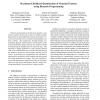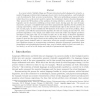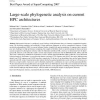77 search results - page 11 / 16 » Reconstructing Phylogenetic Networks Using Maximum Parsimony |
ICMLA
2007
13 years 9 months ago
2007
Dynamic programming is introduced to quantize a continuous random variable into a discrete random variable. Quantization is often useful before statistical analysis or reconstruct...
COCOON
2006
Springer
13 years 11 months ago
2006
Springer
In a recent article, Nakhleh, Ringe and Warnow introduced perfect phylogenetic networks--a model of language evolution where languages do not evolve via clean speciation--and form...
CSB
2003
IEEE
14 years 1 months ago
2003
IEEE
Reverse-engineering of gene networks using linear models often results in an underdetermined system because of excessive unknown parameters. In addition, the practical utility of ...
SP
2008
IEEE
13 years 7 months ago
2008
IEEE
Abstract. Phylogenetic inference is considered a grand challenge in Bioinformatics due to its immense computational requirements. The increasing popularity and availability of larg...
BMCBI
2004
13 years 7 months ago
2004
Background: The prediction of ancestral protein sequences from multiple sequence alignments is useful for many bioinformatics analyses. Predicting ancestral sequences is not a sim...



